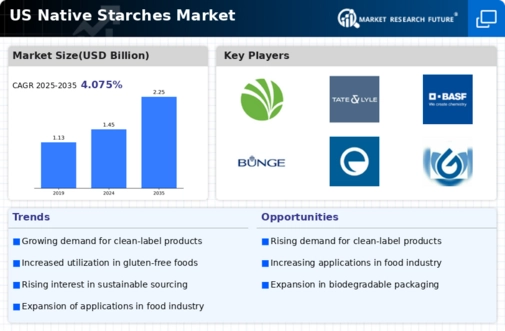Growth in Processed Food Sector
The expansion of the processed food sector in the United States is significantly impacting the native starches market. With busy lifestyles and the increasing demand for convenience foods, consumers are opting for ready-to-eat meals and snacks. Native starches play a crucial role in these products, providing texture, stability, and shelf-life extension. Recent statistics indicate that the processed food market is projected to grow at a CAGR of around 4% through 2026. This growth is expected to drive the demand for native starches, as manufacturers seek to enhance the quality and appeal of their offerings. As a result, the native starches market is likely to benefit from this trend, with companies investing in innovative formulations to cater to the evolving tastes of consumers.
Rising Demand for Natural Ingredients
The increasing consumer preference for natural and clean-label products is driving the native starches market. As consumers become more health-conscious, they are gravitating towards food products that contain fewer artificial additives. This trend is particularly evident in the food and beverage sector, where native starches are utilized as thickening agents, stabilizers, and texturizers. According to industry reports, the demand for natural ingredients in food formulations has surged by approximately 15% over the past few years. This shift towards natural ingredients is likely to continue, as consumers increasingly seek transparency in food labeling. Consequently, manufacturers in the native starches market are adapting their product lines to meet these evolving consumer preferences, thereby enhancing their market presence.
Regulatory Support for Clean Label Products
Regulatory frameworks in the United States are increasingly supporting the use of clean label ingredients, which is beneficial for the native starches market. Agencies such as the FDA are promoting transparency in food labeling, encouraging manufacturers to disclose ingredient sources and production methods. This regulatory environment is fostering a shift towards natural and minimally processed ingredients, including native starches. As a result, food manufacturers are more inclined to incorporate native starches into their formulations to comply with these regulations and meet consumer expectations. The alignment of regulatory support with consumer demand for clean label products is likely to drive growth in the native starches market, as companies strive to enhance their product offerings while adhering to regulatory standards.
Expanding Applications in Non-Food Industries
The native starches market is experiencing growth due to expanding applications in non-food industries, such as pharmaceuticals and cosmetics. In the pharmaceutical sector, native starches are utilized as excipients in drug formulations, providing binding and disintegrating properties. Similarly, in cosmetics, they serve as thickening agents and stabilizers in various products. The increasing demand for natural and effective ingredients in these industries is likely to drive the adoption of native starches. Market analysis suggests that the non-food applications of native starches could account for a substantial share of the overall market by 2027. This diversification of applications is expected to enhance the resilience of the native starches market, as it reduces dependency on the food sector alone.
Technological Advancements in Starch Production
Technological innovations in starch production processes are contributing to the growth of the native starches market. Advances in extraction and processing techniques have improved the efficiency and quality of native starches, making them more appealing to manufacturers. For instance, the development of enzymatic processes has enabled the production of high-purity starches with enhanced functional properties. This is particularly relevant in the food industry, where the demand for high-quality ingredients is paramount. Furthermore, the introduction of sustainable production methods is likely to resonate with environmentally conscious consumers. As a result, the native starches market is expected to witness increased investment in research and development, leading to the introduction of novel starch products that meet the diverse needs of various industries.





















Leave a Comment